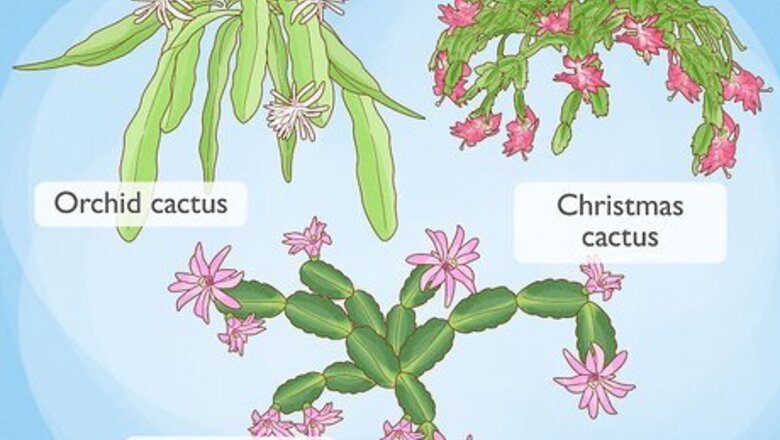
views
Finding the Easter Cactus
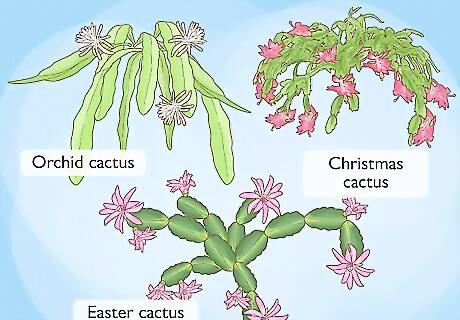
Identify the Easter cactus. Unlike the closely related Christmas cactus the Easter cactus is sold in spring in bloom, starting from March or April. However, if you're in a more well stocked garden center or plant specialist, you might probably run into leftover Christmas cacti on clearance. These two, as well as the Thanksgiving or crab cactus, also are sold as "holiday cacti". Easter cactus, unlike Christmas cactus, has long cladophylls (leaves), which are oval and plain, not short and toothed, wavy or scalloped. The Easter cactus also has flowers that are more open then the other species. The other ones are more closed up, like tulips, and weeping. Epiphyllum or orchid cactus are more robust and larger plants than Easter cactus and are often hybrids of other Epiphyllum species as well as Easter cactus. These plants can be found in bloom anytime spring or summer. You can always ask the dealer or nursery attendant for confirmation of species. Orchid cactus has wavy cladophylls (leaves) that set it apart from Easter cactus. Dwarf Easter cactus, Rhipsalidopsis rosea (pink flowers) and spring cactus Rhipsalidopsis gaertneri (bright scarlet - orange red flowers) are the two main species sold at the same time. Dwarf is smaller and more suitable for smaller rooms. The Rhipsalidopsis and Hatiora names are used for the same species. Also there are new hybrids and colors coming around in the plant trade. New colors are hot (bubblegum/fuchsia pink), white and salmon peach colors.
Growing the Easter Cactus
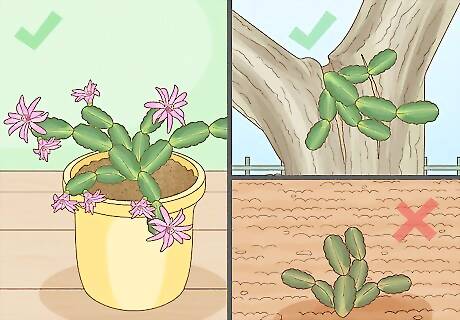
Know the correct growing requirements. The Easter cactus originates from the warm steaming jungles of Brazil. Unlike the desert cacti, this plant is epiphytic, meaning it grows in trees and not on the ground.The Easter cactus is not a very sensitive plant and can tolerate indoor conditions moderately well. A healthy plant is necessary for flowering to occur.
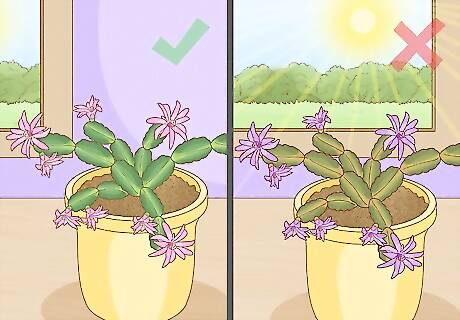
Place the plant in bright indirect light. In the northern hemisphere, if the light is from a north window, you might not have to worry too much about the sunlight being too strong. The same goes for full sun in winter because it's weaker than summer sun. However east, west or south sun is too strong for many plants and the plant must be placed further from the window or a translucent curtain should be placed between the window and the plant. Too much sun will cause Easter cactus to turn yellow and crispy brown. The proper soil to use is a mixture of orchid potting mix and African violet mix. Mix these two in equal parts and add some cactus and succulent mix or garden sand, to help make sure that the soil drains well. It's best not to buy soil mixes with fertilizer already in them, as this can do more harm than good. Regular potting mix is too heavy for Easter cactus. This plant flowers best when its roots are crowded. It doesn't develop a large root system so only repot when it's not growing well and too crowded. Repot it after flowering during the dormant season or in the spring.
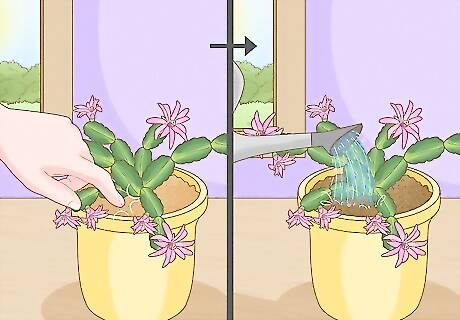
Water carefully. One of the major care issues with Easter cactus is that it's very easy to overwater this plant. Keep your Easter cactus evenly moist and not soggy during growth and flowering. Once the soil surface starts to feel dry to the touch, or the first segment of your (pointer) fingertip is dry when inserting your finger into the soil, the plant needs water. If your plant stems start shriveling and drying out, this means that the plant needs more water. If the plant starts turning yellow and soft your watering too much. Overwatering will cause brown scars on the plants, the plant to turn bluish grey, shrivel up and also the stems to fall off.
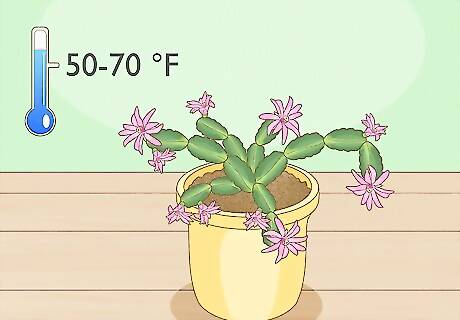
Ensure the right temperature. The preferred range is average room temperature (50 to 70 degree F) A good rule is the higher the temperature in a room, the more moisture a plant needs the lower the temperature the less moisture it needs. The moisture in the air (humidity) and the amount of water in the soil should be adjusted based on this rule depending on the room temperature. Do no expose your plant to extremes like cold and wet or hot and dry. A plant in a cool room grows more slowly, thus using less water and humidity. A plant in a warm room grows faster and this causes water loss. So the warm room plant will use more water and humidity.
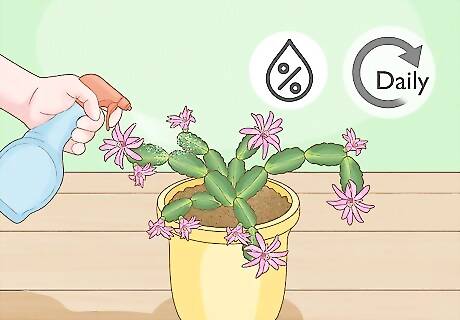
Check the humidity. The plant does well in average humidity. Many sources say mist the plant daily or place it a larger tray with pebbles and water, but often times this leads to rot, fungi, mold and death of the plant. Pay attention to the plant if the stems are shriveling and the soil is moist, raise the humidity when you notice this. If you use a humidifier, indoor water decor, aquarium, or keep the plant cooler than requirements you don't need to raise the humidity.
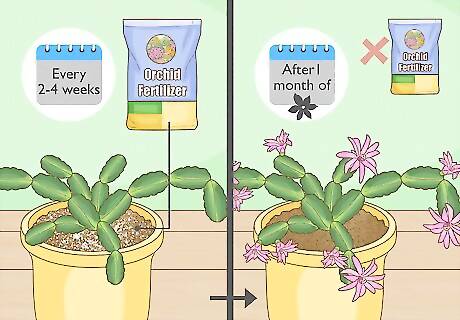
Fertilize the plant every 2 to 4 weeks. When the plant is resting for a month after flowering don't fertilize it at all. Any fertilizer that's for orchids or African violets works well for this plant.
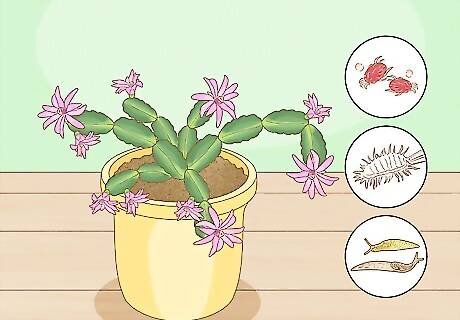
Know the pest and diseases that might occur in keeping Easter cactus. If these are not controlled in a prompt manner the plant will become sickly, stunted and even die. Spider mites are critters that produce fine cobwebs in your plant. These are not attractive to look at and if not gotten rid of, they will start to kill the plant and the plant will die. Many times spider mites are a sign that a plant is too hot and too dry. Cooling the plant down and raising the humidity will get rid of this pest, or help get under control. Mealybugs are white wooly bugs that resemble ghostly pill bugs. They form colonies of white wooly masses mostly in the "notches" or joints of the plant. These pest will not only suck the plant leaves but they can also leave a sticky honeydew trail that is a breeding ground for mold and fungus on infected plants. Scales are hard shelled insects that will resemble hard brown bumps scattered around the plant. They also excrete a sticky honeydew trail that can also support the growth of mildew or mold. You can easily get rid of these pest with by taking a damp cloth drenched in rubbing alcohol and gently wiping the pest off the plant. Drenching the plant with warm water in a shower can also help greatly. Use these techniques to treat all of the pest mentioned above. If the infestation is heavy use any houseplant insecticide following directions on package. Watch out for slugs and snails when placed by open windows or in outdoor situations check for ragged holes in the plant. These guys can be plucked off the plant when seen. Chlorosis is a condition that causes the leaves usually of the center of the plant to turn a weird pale green yellow color. This means the fertilizer your using doesn't contain enough micro-nutrients to keep the plant healthy. All fertilizers contain three basic nutrients for plants.nitrogen(N), phosphorus(P), potassium(K) however some others have other nutrients like copper, selenium which helps plants grow better. Another problem is cold soil temps in the fall. Plastic, glazed or ceramic pots are more insulated than terracotta clay pots. Easter cactus doesn't like to be overwatered! There are several diseases of rot that will occur under soggy conditions. Drechslera Cladophyll Rot will cause black fuzzy spots of Drechslera fungus to grow on the leaves of the cactus. Erwinia Soft Rot causes slimy black spots to start at the soil line and take over the whole plant Fusarium Cladophyll Rot or Rust will cause tan to orange sores on the plant.Pythium and Phytophthora Rot will cause the plant to turn grayish green and roots to turn mushy.These rots cannot be treated and you can try to make cuttings and start new plants or throw the plant out.
Reproducing (Propagating) Easter Cactus
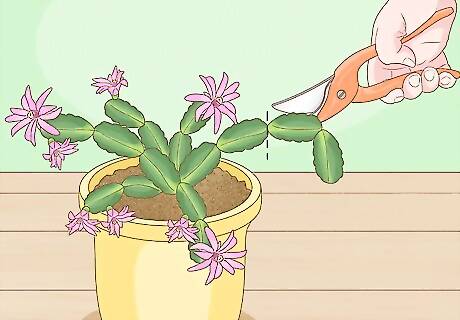
Make cuttings out of lengths of stem counting 2 to 4 "links" or segments. Cut the cuttings at the "notch" of the stem.
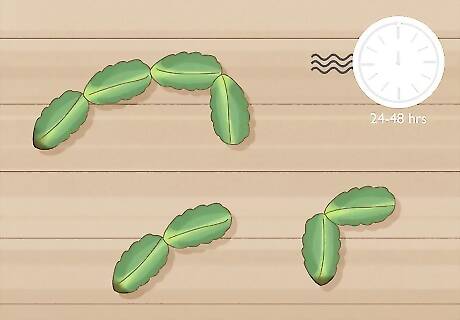
Allow the cuttings to dry and callous (form a brown to black scab) on the cut end for 24 to 48 hours. If you plant it immediately the stem ends will rot.
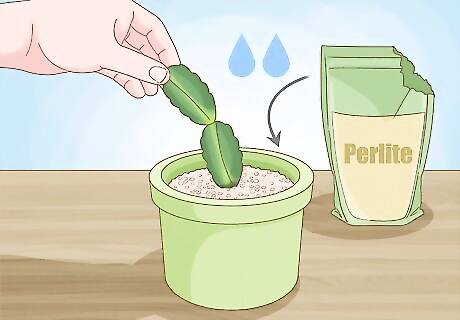
Poke the cut ends into a container of moist perlite. They will root in 1 to 2 months. You can also use moist sand (get your sand from a garden or aquarium shop) or vermiculite.
Getting the Cactus to Bloom
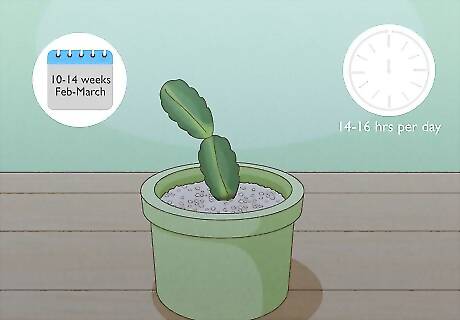
Provide sufficient darkness. The Easter Cactus starts setting blooms once it's experienced a 10 to 14 week period of long cooler nights and shorter days. The length of darkness must be 14 to 16 hours long. Budding will usually start around February or March.
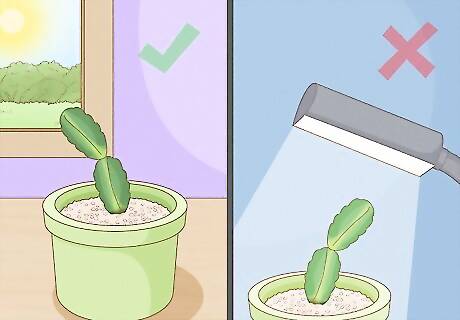
Place the plant in its display area in bright indirect sunlight. The spot needs to be cool (60 to 65) and away from draughts. Draughts are sudden temperature changes like in areas close to windows and doors. Don't put the plant near any heat or electric sources. If the plant is too warm, buds may never form. Temperatures of chilly 50 to 45 degrees also help in bud formation.

Mark your calendar for the day you want your Easter cactus to be in bloom. If you want it time for Easter, you should start around Christmas or New Years. Some new cultivars may require less time.
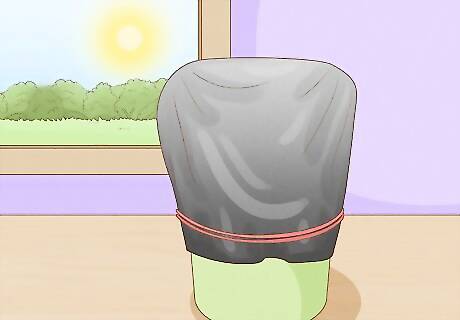
Continue the regular care for the plant and provide the longer nights by blocking out any light from reaching the plant. Any light during this time will interrupt the process and you'll have to start over. You can do this by placing anything that doesn't allow light through, like a box, black plastic bag, or larger flowerpot (with no drainage holes) over the plant. This includes any light! No night lights, candle lights or flashlights. If it's exposed to light during the dark period buds will not set.
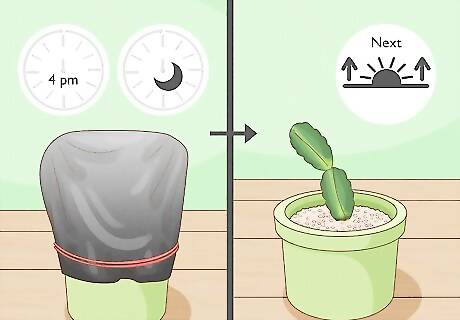
Cover the plant at 4:00pm and leave it covered until next morning when you wake up remove the cover. Don't worry if you don't do this the exact time each time. Just don't keep the plant covered all day the plant will stop growing!
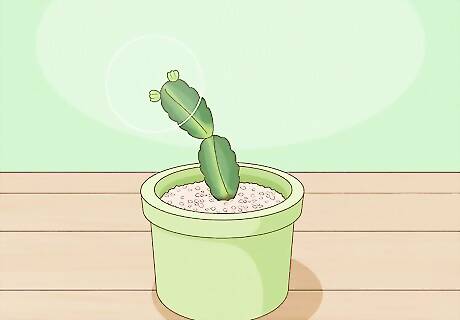
Look for the flower buds to start forming. The tip of the stem will start to swell buds and show color. Once this happens stop the process. If the plant doesn't form flowers it mean that the Easter cactus was kept in too little light and/or the night temperatures were too high. Don't expose the plant to sudden changes in temperature or move it around too much. Doing this will cause the buds to drop before opening. If you forget to water the plant the flowers or expose it to high heat and dry air the flowers will die prematurely.

Enjoy the flowers for a month or more. When the flowers get wilted and die, cut them off. Don't allow them to produce fruits as this well cause the plant to have little energy and produce small, puny flowers the next season.

Rest the plant after the flowering period for a month. Water the plant sparingly (very little) and don't fertilize it. Flowering requires energy for any plant and the plant needs to take a month-long break. If the plant doesn't have this rest period it will not produce flowers the following year. Be careful not to overwater the Easter cactus during this rest period. The plant is not growing and doesn't need extra water. Let the soil dry out and leave the plant alone. When the soil dries to 2 inches (5cm) or more (your entire pointer finger in the soil), then you water.




















Comments
0 comment